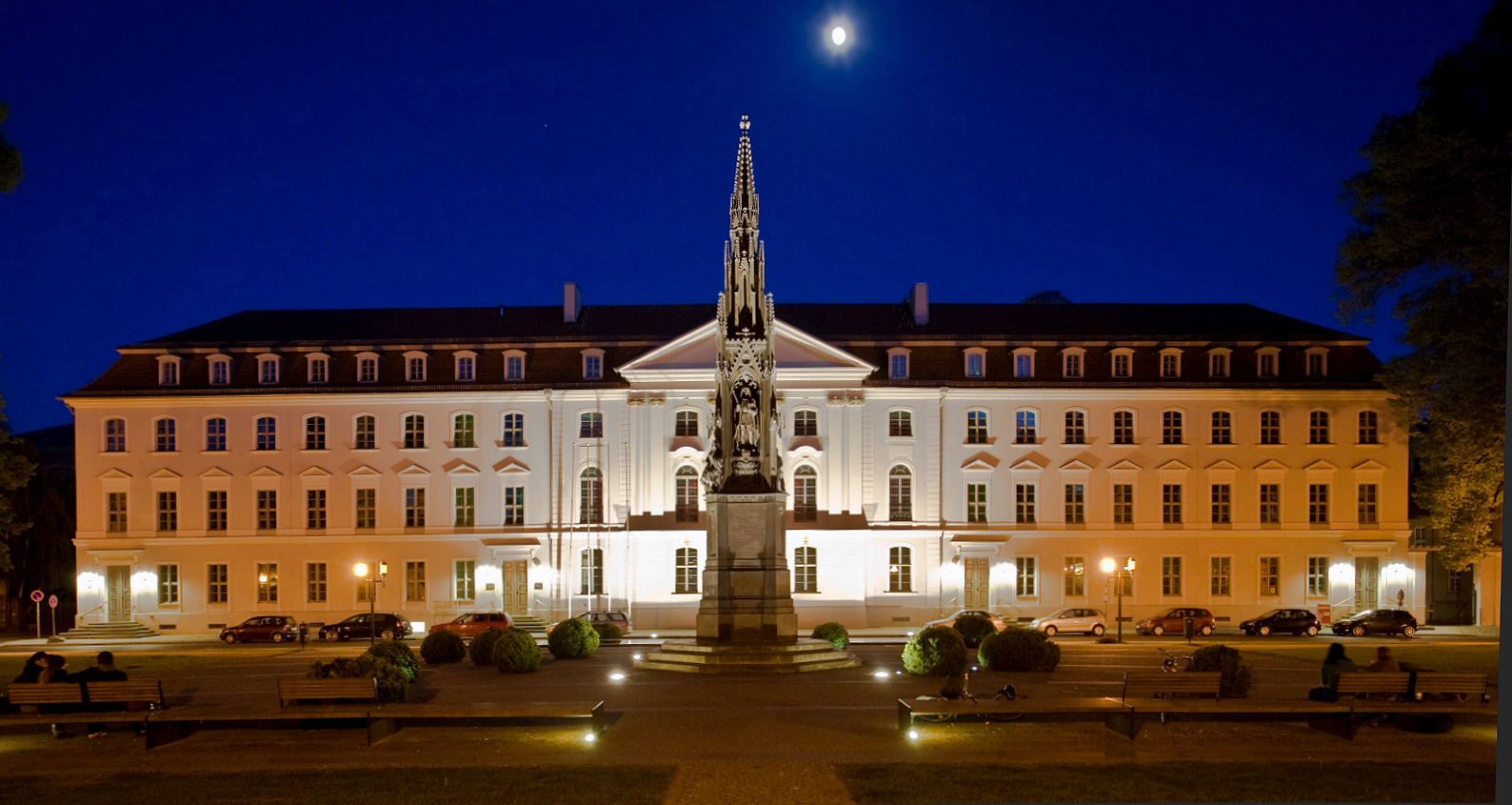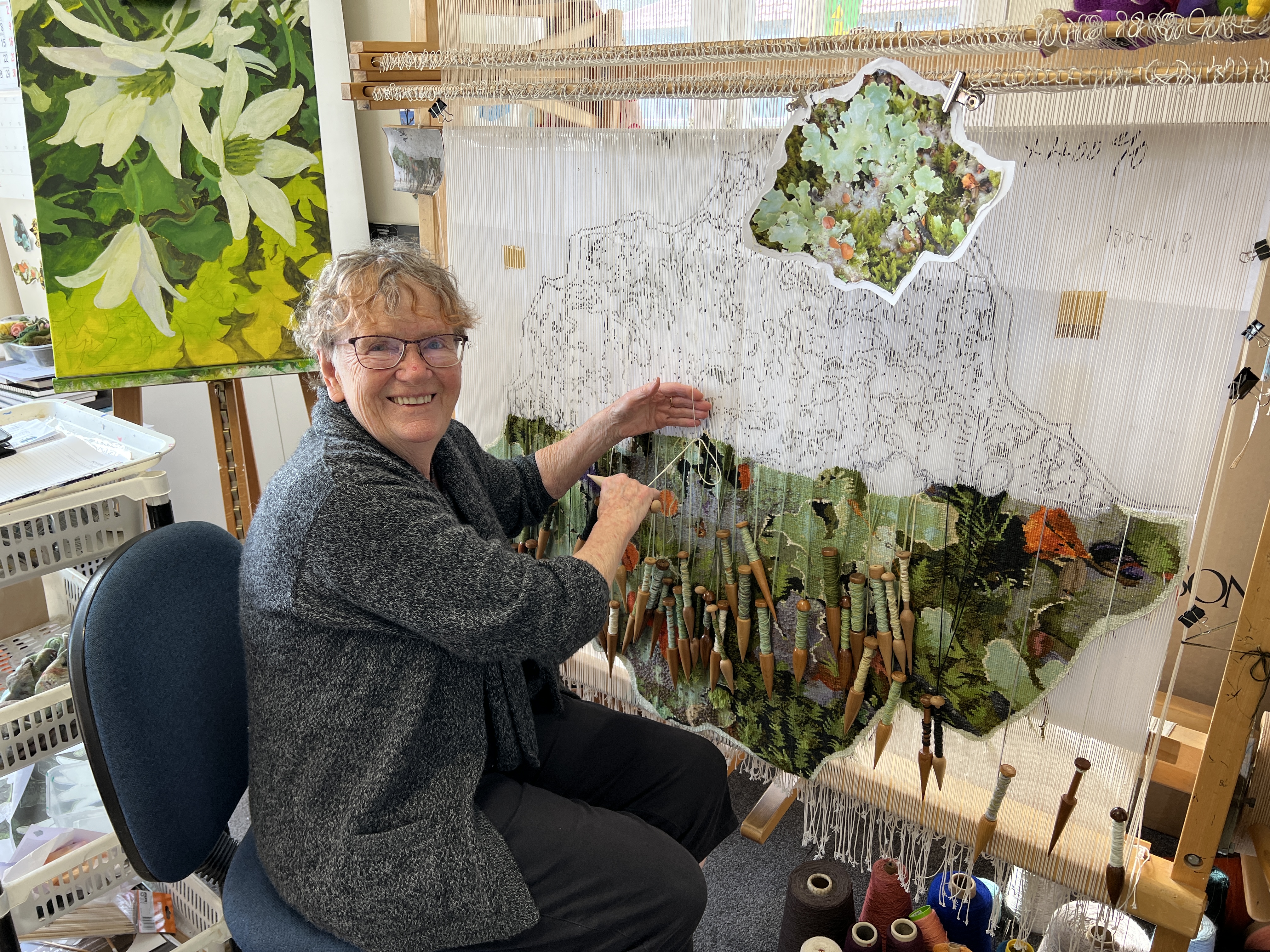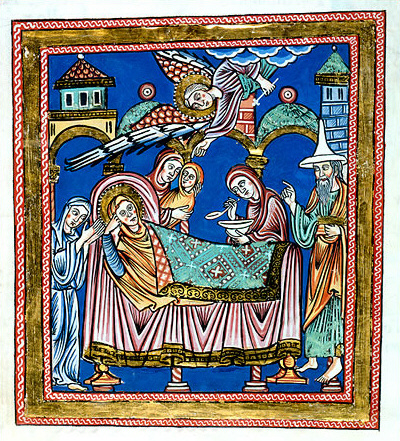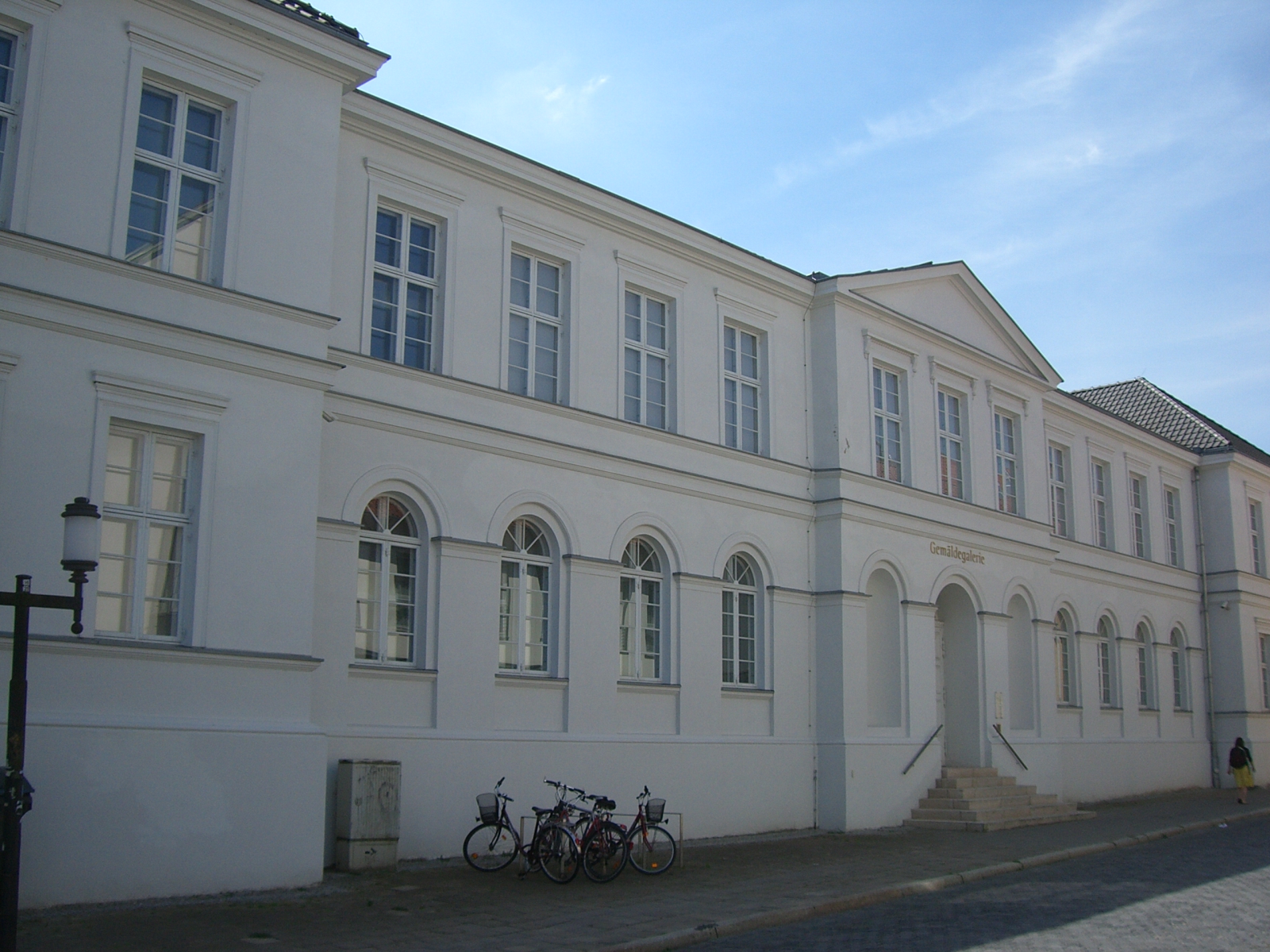|
Croÿ-Teppich
The Croÿ-Teppich (Tapetum Concordiae) is a 6.80 metre long and 4.32 metre tapestry, which is owned by the University of Greifswald. It is considered a unique cultural and historical testimony from the time of the Reformation due to its size, depiction and quality of execution. The work was commissioned by Duke Philip I, Duke of Pomerania in 1554 and made by Peter Heymans, a Dutch image weaver, in Szczecin or Jasienica, Police, Jasenitz. The Loom#Tapestry looms, basse-lisse technique was used. On the carpet is a depiction of the Pomeranian Duke Philip I with his family as well as the family of his wife Maria of Saxony, Duchess of Pomerania, of the Electorate of Saxony, Course of Saxony Princely House on the occasion of the wedding. The figures are arranged below the preaching Martin Luther. Also in the background are the Protestant reformers Philipp Melanchthon and Johannes Bugenhagen. But not only the wedding is to be depicted, but also the longed-for unity of faith within Luthe ... [...More Info...] [...Related Items...] OR: [Wikipedia] [Google] [Baidu] |
Birgit Dahlenburg
Birgit Dahlenburg, ''née'' Handschel (16 April 1959 – 29 January 2017) thueringen-gedenkt.de was a German art historian. She worked as custodian for the art collections of the University of Greifswald and was instrumental in digitising art. Life Born in Heldburg, she studied German studies, art history and art didactics at the University of Greifswald. She received her doctorate in art history there in 1986 with a dissertation on the history of romantic art in Northern Germany. She worked as a research assistant for the Chair of Contemporary Art History from 1987.[...More Info...] [...Related Items...] OR: [Wikipedia] [Google] [Baidu] |
University Of Greifswald
The University of Greifswald (; ), formerly known as Ernst-Moritz-Arndt University of Greifswald, is a public research university located in Greifswald, Germany, in the state of Mecklenburg-Western Pomerania. Founded in 1456, it is one of the oldest universities in Europe, with generations of notable alumni and staff having studied or worked in Greifswald. As the fourth oldest university in present Germany, it was temporarily also the oldest university of the Kingdoms of Sweden (1648–1815) and Prussia (1815–1945), respectively. Approximately two-thirds of the 10,179 students are from outside the state, including international students from 90 countries all over the world. History 1456–1600: Founding The University of Greifswald was founded on 17 October 1456 with the approval of the Holy Roman Empire and the Pope. This was possible due to the great commitment of Greifswald's lord mayor, Heinrich Rubenow, who was also to become the university's first rector, ... [...More Info...] [...Related Items...] OR: [Wikipedia] [Google] [Baidu] |
Philip I, Duke Of Pomerania
Philip I of Pomerania (14 May 1515, in Szczecin, Stettin – 14 February 1560, in Wolgast) was Duke of Pomerania-Wolgast. Life Philip was the only surviving son of Duke George I, Duke of Pomerania, George, from his first marriage to Amalie of the Palatinate. After his mother died, on 6 January 1525, he received his education at the court of his maternal grandfather in Heidelberg. He took office in Stettin at the age of 16, after the death of his father. On 21 October 1532, Philip and his uncle Barnim IX, Duke of Pomerania, Barnim IX split Pomerania, with Philip taking Pomerania-Wolgast (Vorpommern). The division was initially limited to only nine years. It was, however, reconfirmed in 1541. His main advisors were Jobst von Dewitz, Rüdiger von Massow and his Chancellor, Nikolaus Brun. His secretary was the chronicler Thomas Kantzow. When he came to power, his first task was to sort out the relationship with his unloved step-mother, Margaret of Brandenburg, Duchess of Pomerania, ... [...More Info...] [...Related Items...] OR: [Wikipedia] [Google] [Baidu] |
Maria Of Saxony, Duchess Of Pomerania
Maria of Saxony (; 15 December 1515 in Weimar – 7 January 1583 in Wolgast) was a member of the Ernestine line of the house Wettin and a Princess of Saxony by birth and by marriage a Duchess of Pomerania. Life Mary was the eldest daughter of the Elector John "the Steadfast" of Saxony (1468–1532) from his second marriage to Margaret of Anhalt-Köthen (1494–1521), daughter Prince of Waldemar VI of Anhalt-Zerbst. She married on 27 February 1536 in Torgau Duke Philip I of Pomerania (1515–1560). The marriage of the couple is depicted on the so-called Croÿ Tapestry, which shows, in addition to the bridal couple and their families, the Reformers Johannes Bugenhagen, Martin Luther, and Philipp Melanchthon. The tapestry comes from Cranach's workshop and is now in the Pomerania State Museum in Greifswald. During the ceremony, Martin Luther is reported to have dropped one of the rings, whereupon he exclaimed, "Hey, devils, this is none of your business!" The marriage of Phi ... [...More Info...] [...Related Items...] OR: [Wikipedia] [Google] [Baidu] |
Ernst Bogislaw Von Croÿ
Ernst Bogislaw von Croÿ (26 August 1620, in Finstingen (Fénétrange) – 7 February 1684, in Königsberg) was a Lutheran Administrator of the Prince-Bishopric of Cammin and official in the service of Brandenburg-Prussia. Family Ernst Bogislaw was born in Finstingen as the son of Ernst von Croÿ (1588–1620), prince and duke of Croÿ, and Anna of Pomerania (1590–1660), daughter of Bogislaw XIII, Duke of Pomerania. Ernst was the son of Charles Philippe de Cröy, Marquis d’Havré (1549–1613), who was the only son of Philippe II of Croÿ by his second wife, Anna of Lorraine. Although the House of Croÿ was Roman Catholic, his parents' marriage contract called for a Protestant education for their children. A few weeks after Ernst Bogislaw was born, his father fell ill and died on 7 October 1620 near Oppenheim while campaigning during the Thirty Years' War for Ferdinand II, Holy Roman Emperor. Hostile to her husband's family, Anna fled with Ernst Bogislaw to Stetti ... [...More Info...] [...Related Items...] OR: [Wikipedia] [Google] [Baidu] |
Heimo Reinitzer
Heimo Reinitzer (born 24 September 1943) is an Austrian athlete. He competed in the men's discus throw at the 1968 Summer Olympics and the 1972 Summer Olympics The 1972 Summer Olympics (), officially known as the Games of the XX Olympiad () and officially branded as Munich 1972 (; ), were an international multi-sport event held in Munich, West Germany, from 26 August to 11 September 1972. It was the .... References 1943 births Living people Athletes (track and field) at the 1968 Summer Olympics Athletes (track and field) at the 1972 Summer Olympics Austrian male discus throwers Olympic athletes for Austria Place of birth missing (living people) Austrian Athletics Championships winners 20th-century Austrian sportsmen {{Austria-athletics-bio-stub ... [...More Info...] [...Related Items...] OR: [Wikipedia] [Google] [Baidu] |
House Of Griffins
The House of Griffin or Griffin dynasty, (; , ; Latin: ''Gryphes''), or House of Pomerania (see ), was a dynasty ruling the Duchy of Pomerania from the 12th century until 1637. The name "Griffins" was used by the dynasty after the 15th century and had been taken from the ducal coat of arms. Duke Wartislaw I, Duke of Pomerania, Wartislaw I (died 1135) was the first historical ruler of the Duchy of Pomerania and the founder of the Griffin dynasty. The most prominent Griffin was Eric of Pomerania, who became king of the Kalmar Union in 1397, thus ruling Denmark, Sweden, Finland and Norway. The last Griffin duke of Pomerania was Bogislaw XIV, Duke of Pomerania, Bogislaw XIV, who died during the Thirty Years' War, which led to the division of Pomerania between Brandenburg-Prussia, Swedish Empire, Sweden and Crown of the Kingdom of Poland, Poland. Duchess Anna of Pomerania, Anna von Croy, daughter of Duke Bogislaw XIII, Duke of Pomerania, Bogislaw XIII and the last member of the House ... [...More Info...] [...Related Items...] OR: [Wikipedia] [Google] [Baidu] |
Tapestries
Tapestry is a form of textile art which was traditionally woven by hand on a loom. Normally it is used to create images rather than patterns. Tapestry is relatively fragile, and difficult to make, so most historical pieces are intended to hang vertically on a wall (or sometimes in tents), or sometimes horizontally over a piece of furniture such as a table or bed. Some periods made smaller pieces, often long and narrow and used as borders for other textiles. Most weavers use a natural warp thread, such as wool, linen, or cotton. The weft threads are usually wool or cotton but may include silk, gold, silver, or other alternatives. In late medieval Europe, tapestry was the grandest and most expensive medium for figurative images in two dimensions, and despite the rapid rise in importance of painting it retained this position in the eyes of many Renaissance patrons until at least the end of the 16th century, if not beyond. The European tradition continued to develop and reflec ... [...More Info...] [...Related Items...] OR: [Wikipedia] [Google] [Baidu] |
Thomas Wünsch
Thomas Wünsch (born 21 August 1962) is a German historian. Life Born in Landshut, Wünsch studied history, philosophy and Slavic at the University of Regensburg from 1982 to 1988. After studying history, romance, philosophy and Slavic studies under and , he received his doctorate in 1991 with the thesis ''Spiritalis intellegentia. On the allegorical interpretation of the Bible by Petrus Damiani''. From 1991 to 1994, he worked as a historian at the Foundation House of Upper Silesia. He then worked as a research assistant to at the University of Konstanz from 1994 to 1998. There, he completed his habilitation in 1997 with a thesis on ''Conciliarism and Poland''. From 1998 to 2003, Wünsch was a university lecturer in general and East Central European history of the Middle Ages. Since 2003, Wünsch has taught Modern and Contemporary History of Eastern Europe and its Cultures at the University of Passau. He is a member of the and since 2004 co-editor of the ''Zeitschrift für Ostm ... [...More Info...] [...Related Items...] OR: [Wikipedia] [Google] [Baidu] |
Joachim Bahlcke
Joachim was, according to Sacred tradition, the husband of Saint Anne, the father of Mary (mother of Jesus), and the maternal grandfather of Jesus. The story of Joachim and Anne first appears in the Gospel of James, part of the New Testament apocrypha. His feast day is 26 July, a date shared with Saint Anne. In Catholic tradition The story of Joachim, his wife Anne (or Anna), and the miraculous birth of their child Mary, the mother of Jesus, was told for the first time in the 2nd-century apocryphal infancy-gospel the Gospel of James (also called the ''Protoevangelium of James''). Joachim was a rich and pious man, who regularly gave to the poor; however, Charles Souvay, writing in the ''Catholic Encyclopedia'', says that the idea that Joachim possessed large herds and flocks is doubtful. At the temple, Joachim's sacrifice was rejected, as the couple's childlessness was interpreted as a sign of divine displeasure. Joachim consequently withdrew to the desert, where he fasted and did ... [...More Info...] [...Related Items...] OR: [Wikipedia] [Google] [Baidu] |
Pommersches Landesmuseum
The Pomeranian State Museum () in Greifswald, Western Pomerania, is a public museum primarily dedicated to Pomeranian history and arts. The largest exhibitions show archeological findings and artefacts from the Pomerania region and paintings, e.g. of Caspar David Friedrich, a Greifswald local, such as ''Ruins of Eldena Abbey in the Riesengebirge''. The museum was established in the years of 1998 to 2005 at the site of the historical Franziskaner abbey. Near Binz on the nearby isle of Rügen, a satellite of the museum is under construction at '' Jagdschloss Granitz'', a former hunting lodge of the Rugian princes. This branch will be designated to Rugian history. An early 20th century museum in Stettin, then capital of the Province of Pomerania, was the "Provinzialmuseum pommerscher Altertümer", which was also named "Pommersches Landesmuseum" (Pomerania State Museum) since 1934.Werner Buchholz, ''Pommern'', Siedler, 1999, p. 438, Gallery File:Johan Christian Claussen ... [...More Info...] [...Related Items...] OR: [Wikipedia] [Google] [Baidu] |





